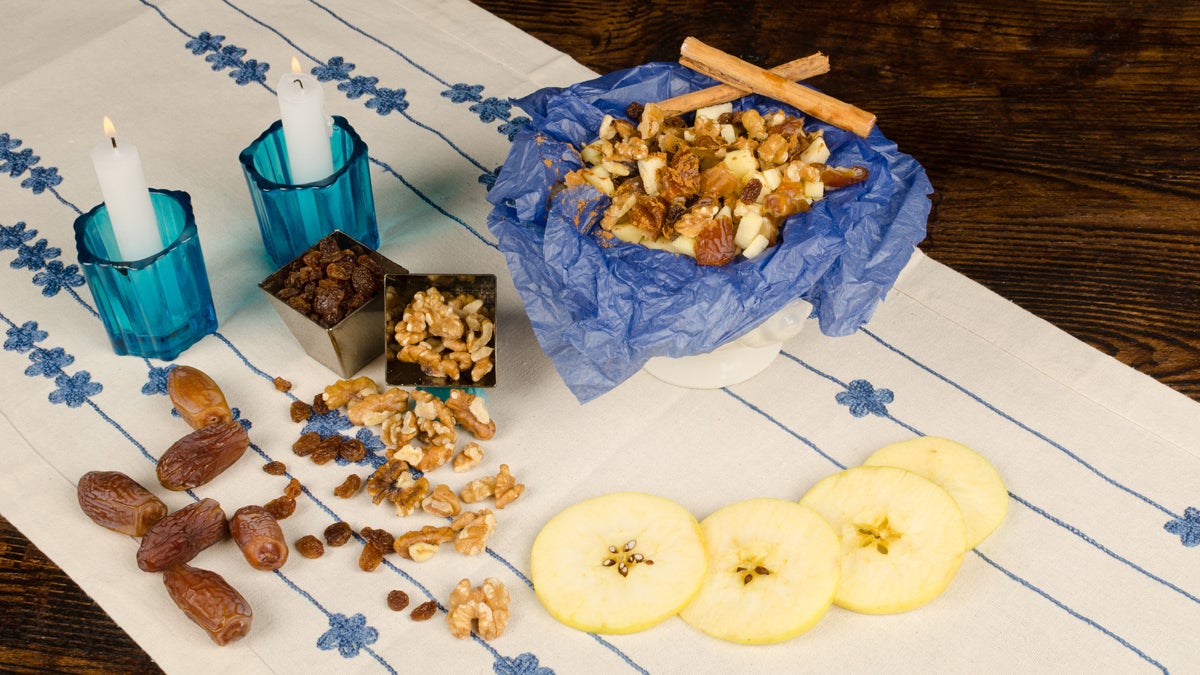Aunt Millie’s charoset, making Passover Seder worth waiting for year after year

(Charoses with ingredients image courtesy of Shutterstock.com. This is not, it should be noted, Aunt Millie's charoset.)
Some families enjoy five-hour Seders, relishing a complete reprise the following night. Some Jews go for the 25-minute version. I prefer the six-minute version.
Q: “Why is this night different from all other nights?”
A: “Because of charoset.”
That’s a joke. (I beg the forgiveness of solemn Jews.) The entire ceremony of the Passover Seder answers that question.
The eight-day Passover holiday commemorates the emancipation of the ancient Israelites from slavery in Egypt. Jews follow the rituals of Passover as a way to retell the stories. The youngest child who is old enough to participate asks the Four Questions, in Hebrew and in English: Mah nishtanah … What makes this night different from all other nights? — followed by questions about what’s on the table.
Some families enjoy five-hour Seders, relishing a complete reprise the following night. Some Jews go for the 25-minute version. I prefer the six-minute version.
A story told in food
The service requires four cups of sweet wine — grape juice for the kids — and prescribed, predictable foods. Each ceremonial item recalls the arduous lives of the Jews while they served as slaves in Egypt (read Exodus for details) and also serves as food for thought.
The tastiest of all, the charoset, appears on tables and in delicatessens only during Passover. It represents the mortar that the Israelites used to make bricks for the Egyptians. By tasting this simultaneously sweet, savory and crunchy side dish, Jews remember that our people, once slaves, are now free.
Parsley, or another green vegetable representing the spring season, gets a dip in salt water, characterizing the tears of the slaves. A hard-boiled egg represents fertility, according to one tradition.
A fiery bite of horseradish stands for the bitterness of slavery. And matzo, of course — the flat, dry foot-square bread that lacks yeast, because in wandering in the desert for 40 years, the Jews had no time to let their bread rise. Counter to what you may have heard, matzo does not taste like cardboard — at least not if it involves charoset.
Some children and adults look forward to charoses most of all. Especially me. I am no cook, but my charoset recipe descends three generations, from my Great Aunt Millie, who hosted all of my childhood Seders. She made the best-ever charoset. I offer the recipe as a gift to anyone preparing or contributing to a Seder.
Aunt Millie’s Charoset
Ingredients:
One 15-ounce box of brown raisins.
Two sweet apples.
6 to 10 ounces of chopped almonds and/or walnuts.
2/3 cup of Kosher-for-Passover red wine – or French or Australian, if you wish.
3/4-cup of sugar or a liberal dose of artificial sweetener.
Generous shakes of powdered cinnamon.
Mash it all up using food processors, fingers, hammers, whatever. I usually fill the processor twice. Feel free to lick and enjoy any spills. If you make it a day ahead, the wine soaks into the mixture more deeply. But even young children can taste it without getting drunk.
This amount serves a Seder for eight and liberal tastings during the meal. You can store it for a week. I usually double the required amount and dole it out on matzo bits to friends of all faiths.
Charoset is why this night is different from all other nights. You busy Monday evening?
WHYY is your source for fact-based, in-depth journalism and information. As a nonprofit organization, we rely on financial support from readers like you. Please give today.

